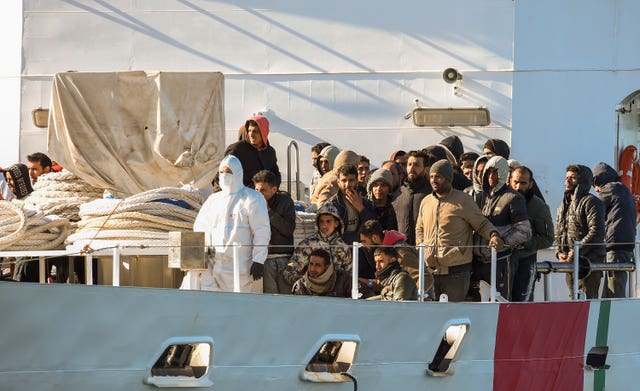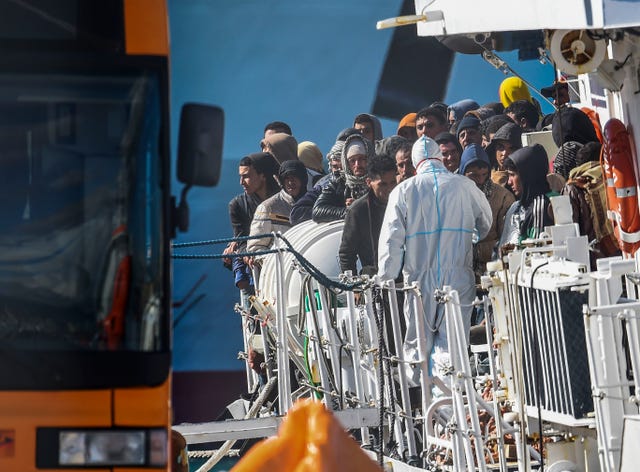
Italy’s right-wing government pressed ahead with plans to crack down on migrants as hundreds arrived at a Sicilian port on Monday after being rescued by the coast guard.
Dozens more were taken on board a charity boat from an unseaworthy vessel operated by smugglers, while others came ashore unaided.
This week, the Senate is due to take up proposed legislation put forward by the government of far-right premier Giorgia Meloni which aims to make it harder for migrants to gain temporary permission to stay in Italy.
Coalition ally Matteo Salvini, who leads the anti-migrant League party, wants the country to eliminate a status known as “special protection” for many of the tens of thousands of migrants who have come ashore in Italy for years now on board smugglers’ boats launched from Libya, Tunisia, Turkey and other places.
That status allows migrants who are unlikely to win refugee status to stay in Italy for two years, pending renewal. During this time, they can work legally and rent housing.

Mr Salvini claims the possibility of “special protection” acts as a “pull factor”, encouraging migrants to leave their homelands in Africa, the Middle East and Asia.
Many of the migrants are fleeing poverty or a lack of decent jobs in sub-Saharan Africa, northern Africa, Pakistan, Bangladesh and Egypt.
While Ms Meloni has said she would like to see that status eliminated, politicians from another coalition party, Silvio Berlusconi’s conservative Forza Italia, have indicated they could push for the time to be slashed from two years to six months.
“It’s not so much a question of numbers, but of (sending) a signal of severity that we want to give,” prominent Forza Italia senator Maurizio Gasparri was quoted as saying in Corriere della Sera on Monday.
The number of migrants arriving this spring has risen relentlessly.
A coast guard boat with about 200 migrants on board pulled into the harbour in Catania, Sicily, early on Monday.
They were among some 600 migrants rescued by the coast guard during the weekend in Malta’s search-and-rescue sector of the Mediterranean. For years, humanitarian groups have lamented that Maltese authorities often ignore distress calls from foundering migrant vessels.
The others arrived in Catania late on Sunday on board a vessel operated by Frontex, the European Union’s border protection agency.
Also on Sunday, an Italian naval vessel took some 300 rescued migrants to another Sicilian port, Augusta, Italian media said.

Fifty-five migrants arrived on the island of Lampedusa after being rescued by a humanitarian vessel over the weekend.
Separately, residents of the tiny tourist and fishing island, closer to Tunisia than to the Italian mainland, spotted several migrants, who apparently reached Lampedusa without the need for rescue, walking on a beach.
By Sunday night, the centre which shelters migrants on Lampedusa was holding nearly 800 people, nearly double its supposed capacity.
The migrants are accommodated there before being transferred elsewhere in Italy while their claims for asylum are processed.
Government authorities were arranging for ferries to take some to Sicily or the mainland to help ease overcrowding.
Ms Meloni’s government last week declared a six-month national state of emergency to help cope with the influx of migrants, mainly by shortening the time need to fund or erect new housing or repatriation centres for those losing asylum bids.
By Monday, roughly 33,000 migrants had arrived in the year to date, compared with about 8,500 in the same period in each of the last two years.
On Sunday, interior ministry official Valerio Valenti, who heads an immigration office, was appointed as the commissioner to lead the emergency response.
The governors of four left-led regions immediately refused to back the appointment, indicating they would not work with whatever his plans would be to open new housing or repatriation centres.
Among the regions is Emilia-Romagna, which has accepted the highest number of migrants in Italy after Lombardy, another northern region.
How their pushback will affect Mr Valenti’s efficiency was not immediately clear.


Comments: Our rules
We want our comments to be a lively and valuable part of our community - a place where readers can debate and engage with the most important local issues. The ability to comment on our stories is a privilege, not a right, however, and that privilege may be withdrawn if it is abused or misused.
Please report any comments that break our rules.
Read the rules hereLast Updated:
Report this comment Cancel